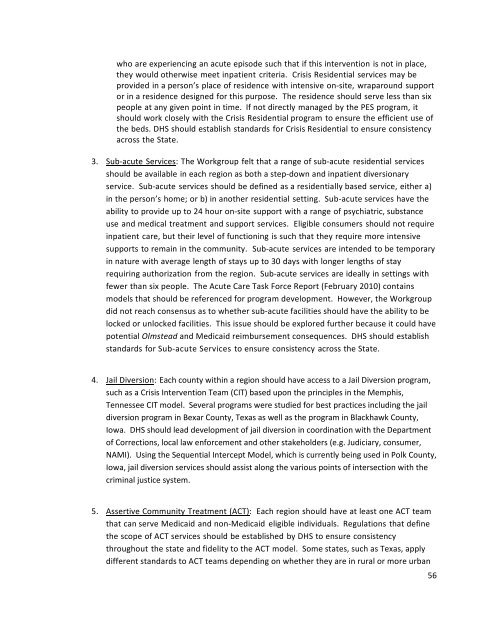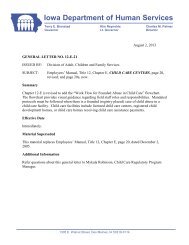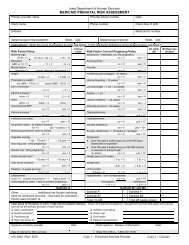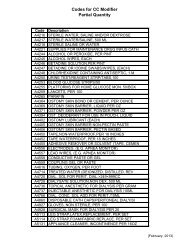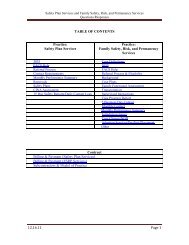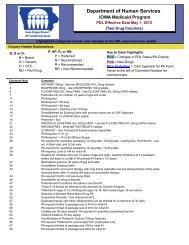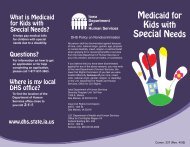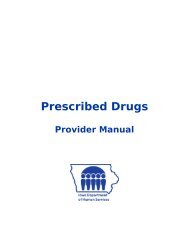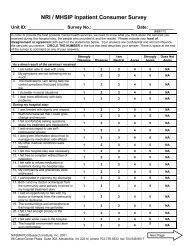Iowa Mental Health and Disability Services System Redesign Interim ...
Iowa Mental Health and Disability Services System Redesign Interim ...
Iowa Mental Health and Disability Services System Redesign Interim ...
- No tags were found...
Create successful ePaper yourself
Turn your PDF publications into a flip-book with our unique Google optimized e-Paper software.
who are experiencing an acute episode such that if this intervention is not in place,<br />
they would otherwise meet inpatient criteria. Crisis Residential services may be<br />
provided in a person’s place of residence with intensive on-site, wraparound support<br />
or in a residence designed for this purpose. The residence should serve less than six<br />
people at any given point in time. If not directly managed by the PES program, it<br />
should work closely with the Crisis Residential program to ensure the efficient use of<br />
the beds. DHS should establish st<strong>and</strong>ards for Crisis Residential to ensure consistency<br />
across the State.<br />
3. Sub-acute <strong>Services</strong>: The Workgroup felt that a range of sub-acute residential services<br />
should be available in each region as both a step-down <strong>and</strong> inpatient diversionary<br />
service. Sub-acute services should be defined as a residentially based service, either a)<br />
in the person’s home; or b) in another residential setting. Sub-acute services have the<br />
ability to provide up to 24 hour on-site support with a range of psychiatric, substance<br />
use <strong>and</strong> medical treatment <strong>and</strong> support services. Eligible consumers should not require<br />
inpatient care, but their level of functioning is such that they require more intensive<br />
supports to remain in the community. Sub-acute services are intended to be temporary<br />
in nature with average length of stays up to 30 days with longer lengths of stay<br />
requiring authorization from the region. Sub-acute services are ideally in settings with<br />
fewer than six people. The Acute Care Task Force Report (February 2010) contains<br />
models that should be referenced for program development. However, the Workgroup<br />
did not reach consensus as to whether sub-acute facilities should have the ability to be<br />
locked or unlocked facilities. This issue should be explored further because it could have<br />
potential Olmstead <strong>and</strong> Medicaid reimbursement consequences. DHS should establish<br />
st<strong>and</strong>ards for Sub-acute <strong>Services</strong> to ensure consistency across the State.<br />
4. Jail Diversion: Each county within a region should have access to a Jail Diversion program,<br />
such as a Crisis Intervention Team (CIT) based upon the principles in the Memphis,<br />
Tennessee CIT model. Several programs were studied for best practices including the jail<br />
diversion program in Bexar County, Texas as well as the program in Blackhawk County,<br />
<strong>Iowa</strong>. DHS should lead development of jail diversion in coordination with the Department<br />
of Corrections, local law enforcement <strong>and</strong> other stakeholders (e.g. Judiciary, consumer,<br />
NAMI). Using the Sequential Intercept Model, which is currently being used in Polk County,<br />
<strong>Iowa</strong>, jail diversion services should assist along the various points of intersection with the<br />
criminal justice system.<br />
5. Assertive Community Treatment (ACT): Each region should have at least one ACT team<br />
that can serve Medicaid <strong>and</strong> non-Medicaid eligible individuals. Regulations that define<br />
the scope of ACT services should be established by DHS to ensure consistency<br />
throughout the state <strong>and</strong> fidelity to the ACT model. Some states, such as Texas, apply<br />
different st<strong>and</strong>ards to ACT teams depending on whether they are in rural or more urban<br />
56


